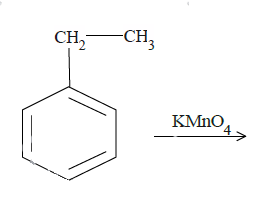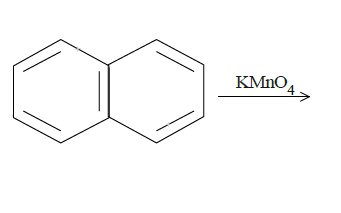
Answer
468.9k+ views
Hint: Reaction with $KMn{O_4}$ attacks the benzylic carbon which is the carbon atom next to benzene. If there is at least one hydrogen atom on the carbon atom, the reaction will cut the carbon atom from other links and convert it to a carboxyl group. The last problem is the epoxidation reaction where the double bond will break to form an epoxy.
Complete answer:
$KMn{O_4}$ is a strong oxidizing agent and is most commonly used in oxidation reactions of organic compounds. The final results are often carboxylic compounds. In (a) and (b), reaction with $KMn{O_4}$ will convert the benzylic carbon to carboxyl group. Now it is very important that there is at least one hydrogen atom at the benzylic carbon position. $KMn{O_4}$ attacks at the weak bonds of the compounds like the covalent double or triple bonds. In case of aromatic compounds, the C-H bond for carbon at the alpha position with respect to benzene molecules is a weak bond. In case of (a), it will react with the benzyl carbon cutting its bond with the methyl group later and convert it to the carboxyl group.
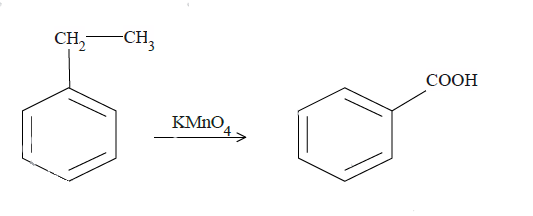
In case of (b), ketone carbon will be oxidized to the carboxyl group.

In (c), we have naphthalene reacted with $KMn{O_4}$. It will produce benzene with two carboxyl groups on adjacent carbon atoms on the benzene ring breaking one ring. The reaction is as follows:
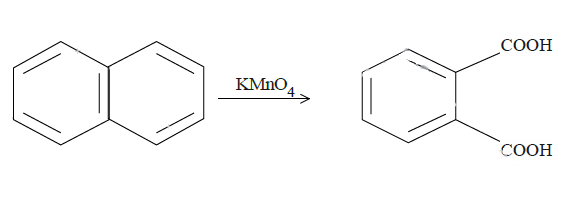
In question (d), we have been asked to give results for two reactions. In the top one, mild $KMn{O_4}$ will break the double bond and add hydroxyl groups to adjacent carbon atoms. The dark lines tell the bonds are on the same side of the original double bond since it is formed by breaking the double bond and attacking the adjacent carbon bonds from the same side by the manganate ion. The cold diluted conditions mean the conditions are mild and thus this product. Reaction on the bottom is an example of epoxidation. One oxygen from the reactant will attack the double bond and attach itself to both the carbon atoms. Both the reactions are as follows:
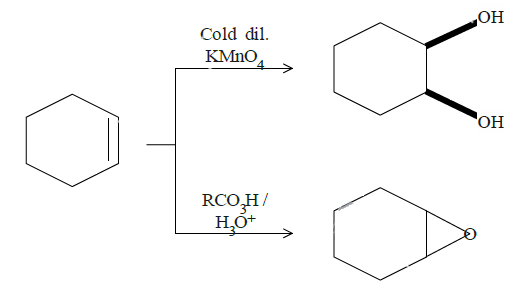
Note: In the first part of the last reaction, if there is heat added to the reaction and more concentrated $KMn{O_4}$ then the glycol we have estimated will oxidise further and also breaking the bond between the adjacent carbon atoms to form chain compound with carboxyl group at the ends. $KMn{O_4}$ is generally not used in the productions of aldehydes and ketones because of its strong oxidizing nature.
Complete answer:
$KMn{O_4}$ is a strong oxidizing agent and is most commonly used in oxidation reactions of organic compounds. The final results are often carboxylic compounds. In (a) and (b), reaction with $KMn{O_4}$ will convert the benzylic carbon to carboxyl group. Now it is very important that there is at least one hydrogen atom at the benzylic carbon position. $KMn{O_4}$ attacks at the weak bonds of the compounds like the covalent double or triple bonds. In case of aromatic compounds, the C-H bond for carbon at the alpha position with respect to benzene molecules is a weak bond. In case of (a), it will react with the benzyl carbon cutting its bond with the methyl group later and convert it to the carboxyl group.

In case of (b), ketone carbon will be oxidized to the carboxyl group.

In (c), we have naphthalene reacted with $KMn{O_4}$. It will produce benzene with two carboxyl groups on adjacent carbon atoms on the benzene ring breaking one ring. The reaction is as follows:

In question (d), we have been asked to give results for two reactions. In the top one, mild $KMn{O_4}$ will break the double bond and add hydroxyl groups to adjacent carbon atoms. The dark lines tell the bonds are on the same side of the original double bond since it is formed by breaking the double bond and attacking the adjacent carbon bonds from the same side by the manganate ion. The cold diluted conditions mean the conditions are mild and thus this product. Reaction on the bottom is an example of epoxidation. One oxygen from the reactant will attack the double bond and attach itself to both the carbon atoms. Both the reactions are as follows:

Note: In the first part of the last reaction, if there is heat added to the reaction and more concentrated $KMn{O_4}$ then the glycol we have estimated will oxidise further and also breaking the bond between the adjacent carbon atoms to form chain compound with carboxyl group at the ends. $KMn{O_4}$ is generally not used in the productions of aldehydes and ketones because of its strong oxidizing nature.
Recently Updated Pages
10 Examples of Evaporation in Daily Life with Explanations

10 Examples of Diffusion in Everyday Life

1 g of dry green algae absorb 47 times 10 3 moles of class 11 chemistry CBSE

What happens when dilute hydrochloric acid is added class 10 chemistry JEE_Main

What is the meaning of celestial class 10 social science CBSE

What causes groundwater depletion How can it be re class 10 chemistry CBSE

Trending doubts
Fill the blanks with the suitable prepositions 1 The class 9 english CBSE

Which are the Top 10 Largest Countries of the World?

How do you graph the function fx 4x class 9 maths CBSE

Differentiate between homogeneous and heterogeneous class 12 chemistry CBSE

Difference between Prokaryotic cell and Eukaryotic class 11 biology CBSE

Change the following sentences into negative and interrogative class 10 english CBSE

The Equation xxx + 2 is Satisfied when x is Equal to Class 10 Maths

In the tincture of iodine which is solute and solv class 11 chemistry CBSE

Why is there a time difference of about 5 hours between class 10 social science CBSE

